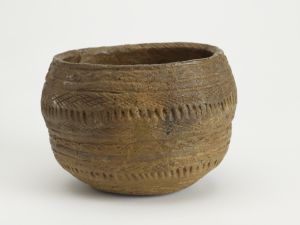Archaeology
Prehistory
Prehistory refers to a time long ago when as far as we know, people could not read or write. To help us understand what life was like at this time, we need to examine objects and look for clues.
Early Medieval Ireland (400—1200AD)
Saint Patrick is believed to have brought Christianity to Ireland. With Christian teaching came writing and for the first time there were accounts of news and events as they happened. Churches and monasteries became the focus of people’s lives and fine metal objects, such as the Clonmore shrine, were designed for use in church ceremonies. Most people lived in farms known as raths. In a few places such as Armagh, others began to settle in towns.
The Vikings shattered this religious way of life. They swept down from Scandinavia landing along the coast. Their shallow longships penetrated far inland by river. They ransacked monasteries and pillaged raths. Eventually they began to settle, trading and building homes. Dublin was their main port.
This period of calm did not last long as new wave of invaders were ready to land.
Late Medieval Ireland (1200—1600 AD)
In 1066 the Norman (French) king, William the Conqueror, famously defeated English King Harold at the Battle of Hastings. England became a Norman kingdom.
Just over a century later, in 1169, these Anglo-Normans began an invasion of Ireland. They built strong stone castles as symbols of power to help control the local population. Carrickfergus Castle is a good example of such a stronghold. It made Carrickfergus the most important town and trading port in the north of Ireland.
Their presence was resisted b the older, Gaelic way of life. Fighting would continue between Irish chieftains and English lords for the next five centuries. Typical weapons and armour of this period include helmets, swords, and crossbows.
Despite this ongoing conflict, trade flourished as seen in the greater number and variety of coins.
Treasure
Many important objects are found by people who are not archaeologists. If you think you have found something of interest, you will find more information on what to do next on our "What have I found?" page.

BELUM.BGR.431
Cross of a Knight of Santiago de Compostela
Cross

BELUM.A2023.4
Reliquary

BELUM.A1910.669
Lunula

BELUM.A157.1926
Lunula

BELUM.BGR.13
Ring

BELUM.BGR.11
Ring

BELUM.BGR.9
Ring

BELUM.BGR.23
CHAIN; Gold chain

BELUM.A249.1910
Pot : urn : cordoned

BELUM.A5035
Pot : urn : reconstructed

BELUM.A26422
Pot

BELUM.AX40.11
Pot : food vessel : vase urn

BELUM.A3957
Pot : vase urn

BELUM.A1337
Pot : food vessel : vase : tripartite

BELUM.A300.1934
Pot : food vessel : bowl : tripartite

BELUM.A26409
Pot : food vessel : bowl: tripartite

BELUM.A7949
Pot : food vessel : bowl : bipartite : necked

BELUM.A578.1924
Pot : food vessel : pygmy cup

BELUM.A281.1964
Sleeve-fasterner : discless

BELUM.A210.1913
Ring-money

BELUM.A207.1913
Sleeve-fastener

BELUM.A200.1913
Lunula

BELUM.A2A.1968
Ear-ring : bar-twisted

BELUM.BGR.155
Astrolabe

BELUM.A26389
Pot

BELUM.A783.1963
Pot : food vessel : bowl : tripartite : variant

BELUM.A323.1911
Pot : food vessel : bowl : ribbed

BELUM.A26410
Pot

BELUM.A26319
Pot

BELUM.A3928
Pot : food vessel : vase : tripartite

BELUM.A26387
Pot

BELUM.A26384
Pot

BELUM.A26383
Pot

BELUM.A26382
Pot

BELUM.A4030
Pot : urn : reconstructed

BELUM.AX40.10
Pot : food vessel : vase urn

BELUM.A332.1924
Pot : food vessel

BELUM.BGR.62
TAPERSTICK; Silver taper-stick

BELUM.A26405
Pot

BELUM.A26381
Pot

BELUM.A26406
Pot

BELUM.A110.1948
Pot : urn

BELUM.AX40.17
Pot : food vessel : vase : bipartite

BELUM.AX40.7.1
Pot : food vessel : vase : bipartite

BELUM.A81.1954
Pot : food vessel : bowl : bipartite : variant

BELUM.A3.1990
Pot : urn : vase

BELUM.A26401
Pot

BELUM.A7953
Pot : food vessel : bowl

BELUM.A283.1964
Pot : food vessel : bowl : ribbed

BELUM.A249.1924
Pot : urn : encrusted

BELUM.A828.1914
Pot : urn : encrusted

BELUM.A246.1928
Pot : urn : cordoned


